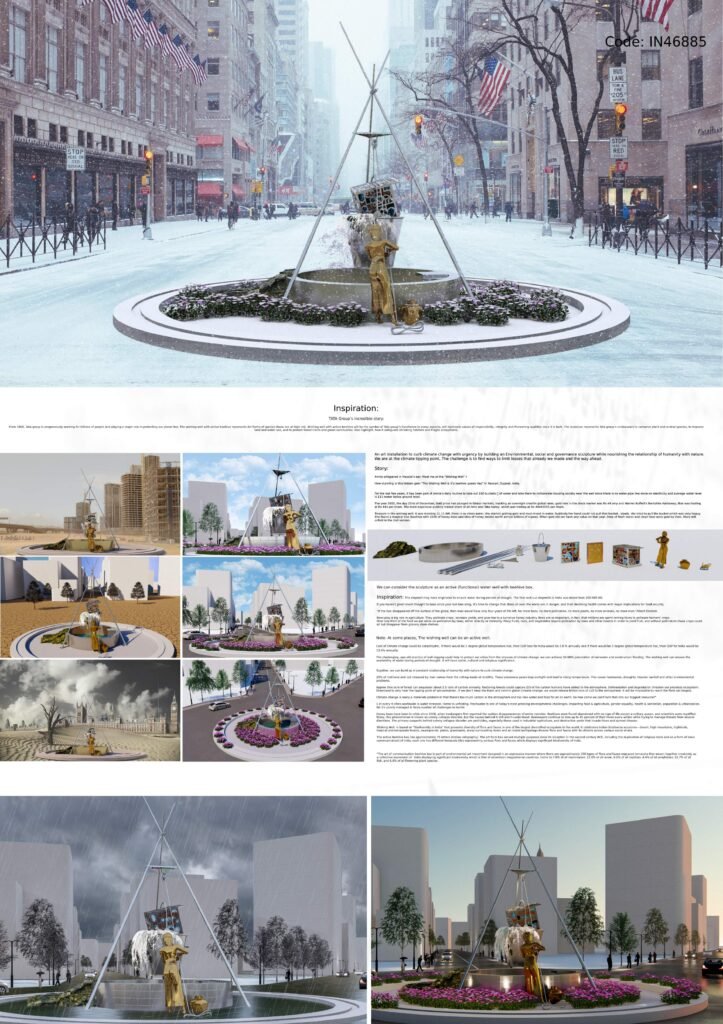An art installation to curb climate change with urgency by building an Environmental, social and governance sculpture while nourishing the relationship of humanity with nature. We are at the climate tipping point, The challenge is to find ways to limit losses that already we made and the way ahead.
Story:
Amira whispered in Massiel’s ear: Meet me at the “Wishing Well” !
How stunning is this hidden gem “The Wishing Well & it’s beehive queen Vay“ in Navsari, Gujarat, India.
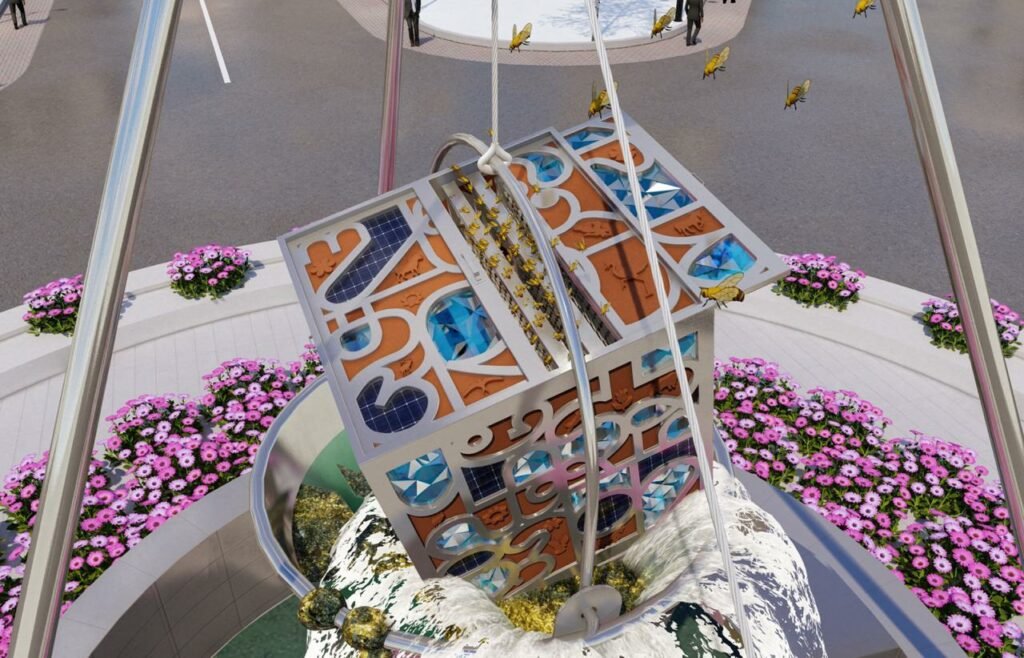
For the last few years, it has been part of Amira’s daily routine to take out 100 buckets of water and take them to millionaires housing society near the well since there is no water pipe line since no electricity and average water level is 111 meter below ground level.
The year 2055, the day 22nd of December, Gold price had plunged in Global markets, tracking an overnight crashin global rates. gold rate in the stock market was Rs 44 only and Warren Buffett’s Berkshire Hathaway, that was trading at Rs 444 per share. The most expensive publicly traded share of all time was Tata honey, which was trading at Rs 44445555 per share.
Treasure in the wishing well: It was morning 11.11 AM, there is no clean water. she started getting gold and mud mixed in water. Suddenly her hand could not pull that bucket , slowly she tried to pull the bucket which was very heavy. She found a magical box (beehive with 1000 of honey bees and kilos of honey inside) worth almost billions of rupees. When gold did not have any value on that year. Drop of fresh water and clean food were gold by then. Story will unfold in the 2nd version.
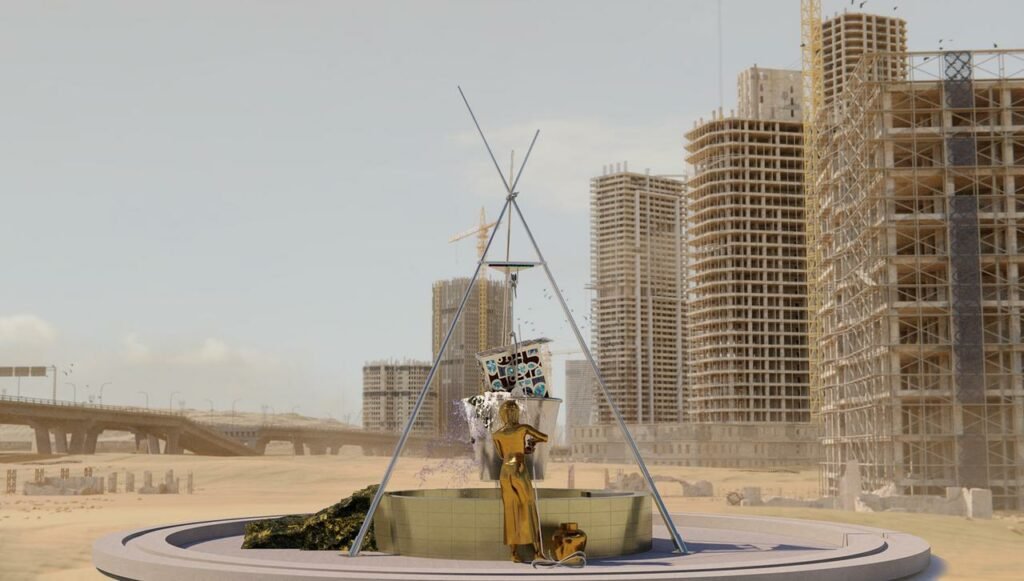
We can consider the sculpture as an active (functional) water well with beehive box.
Inspiration: The stepwell may have originated to ensure water during periods of drought. The first rock-cut stepwells in India was dated from 200-400 AD.
If you haven’t given much thought to bees since your last bee sting, it’s time to change that. Bees all over the world are in danger, and their declining health comes with major implications for food security.
“If the bee disappeared off the surface of the globe, then man would have only four years of life left. No more bees, no more pollination, no more plants, no more animals, no more man.”Albert Einstein
Bees play a big role in agriculture. They pollinate crops, increase yields, and give rise to a lucrative honey industry. Bees are so important, in fact, that millions are spent renting hives to pollinate farmers’ crops.
Over one third of the food we eat relies on pollination by bees, either directly or indirectly. Many fruits, nuts, and vegetables require pollination by bees and other insects in order to yield fruit, and without pollinators these crops could all but disappear from grocery store shelves.
Note: At some places, The wishing well can be an active well.
Cost of climate change could be catastrophic, if there would be 2 degree global temperature rise, then GDP loss for India would be 2.6 % annually and if there would be 3 degree global temperature rise, then GDP for India would be 13.4% annually.
The challenging, age-old practice of well-digging could help to protect our cities from the stresses of climate change. we can achieve 50-60% percolation of rainwater and avoid urban flooding. The wishing well can ensure the availability of water during periods of drought. It will have social, cultural and religious significance.
Together, we can build up A constant relationship of humanity with nature to curb climate change.
20% of methane and co2 released by man comes from the rotting waste at landfills. These poisonous gases trap sunlight and lead to rising temperature. This cause heatwaves, droughts, heavier rainfall and other environmental problems.
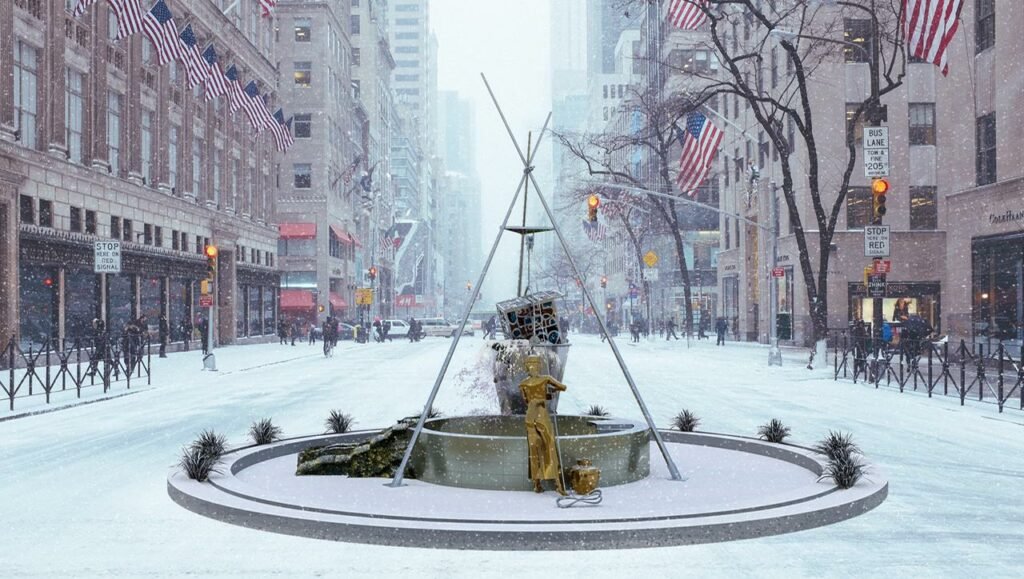

Approx One acre of forest can sequester about 2.5 tons of carbon annually. Restoring forests could capture 2/3 of the carbon humans have added to the atmosphere. Deforestation and degradation threaten our priceless ecosystem. Greenland is very near the tipping point of savvanisation , If we don’t keep the track and control global climate change, we would release billion tons of co2 to the atmosphere. It will be impossible to reach the Paris set targets.
Climate change is really a materials problem in that there’s too much carbon in the atmosphere and too less water and food for all on earth. So how come we can’t turn that into our biggest resource?”
1 in every 4 cities worldwide is water stressed. Horror is unfolding. Freshwater is one of today’s most pressing developmental challenges, impacting food & agriculture, gender equality, health & sanitation, population & urbanization. Yet it’s poorly managed & faces number of challenges to tackle.
Honey bees have been in crisis since 2006, when beekeepers first reported the sudden disappearances of entire colonies. Beehives were found abandoned with no sign of life except a solitary queen, and scientists were mystified. Today, this phenomenon is known as colony collapse disorder, but the causes behind it still aren’t understood. Beekeepers continue to lose up to 45 percent of their hives every winter while trying to manage threats from several directions. The primary suspects behind colony collapse disorder are pesticides, especially those used in industrial agriculture, and destructive pests that invade hives and spread disease.
Wishing Well is based on “Biodiversity in India” that presents diversity of flora and fauna in one of the largest diversified ecosystem in the world. It celebrates Indian biodiverse ecozones—desert, high mountains, highlands, tropical and temperate forests, swamplands, plains, grasslands, areas surrounding rivers and an island archipelago diverse flora and fauna with its citizens across various social strata.
The active beehive box has approximately 75 letters (Indian calligraphy). The art form has served multiple purposes since its inception in the second century BCE, including the duplication of religious texts and as a form of basic communication) of India, each one has different terracota tiles representing various flora and fauna which displays significant biodiversity of India.
“The art of communication beehive box is part of environmental art movement designed in an expressive manner where there are approximately 150 types of flora and fauna engraved terracota tiles woven together creatively as a collective expression of India displaying significant biodiversity which is One of seventeen megadiverse countries, home to 7.6% of all mammalian, 12.6% of all avian, 6.2% of all reptilian, 4.4% of all amphibian, 11.7% of all fish, and 6.0% of all flowering plant species.

The wishing well beehive box has multiple letters (calligraphy) from different languages of India through which we express our wondrous love. Those letters are filled with distinct handcrafted terracota tiles with motifs of historical monuments, dance forms, flora, fauna showcasing rich cultural heritage and few letters filled with prismatic glasses that celebrate different colours of life when it falls on ground (representing equality for all) and few letters are filled with solar panels that generate electricity to make it a self sufficient sculpture.
Note: These sculptures can represent any particular regional based art forms, letters to make it a regional sculpture to connect with the immediate surrounding and its indigenous people.
The wishing well sculpture can be a place of social interaction and public discourse. These will be the locations of open debates, voicing public concerns, and engaging citizens in discussions about contemporary issues like climate-change, equal rights for all, food security and water crisis.
Visual art beehive box designed to communicate through 22 recognised scheduled languages’ first alphabets (like first letter of Hindi, Odia, Assamese, Punjabi, Telugu, Malayalam, Tamil, Urdu, Bengali, Gujarati, Marathi, Kannada, Kankoni and so on)

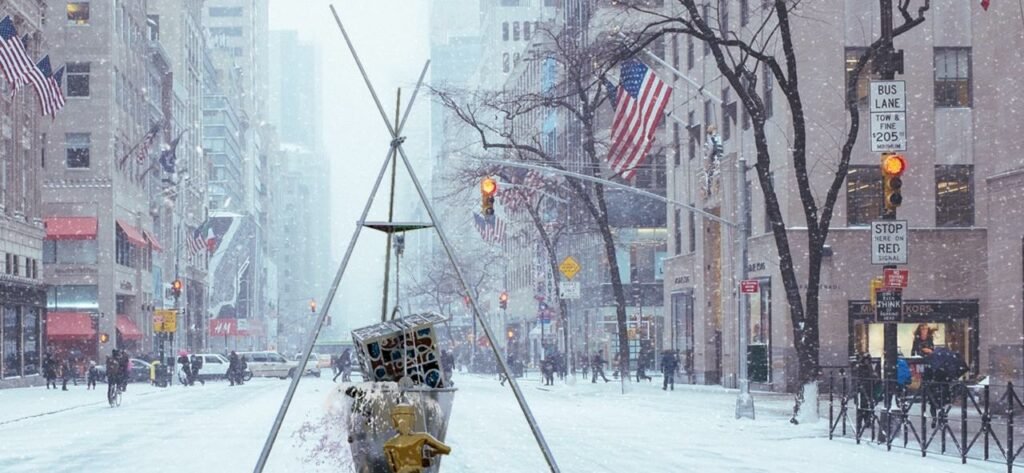
The stepwell may have originated to ensure water during periods of drought. The first rock-cut stepwells in India date from 200-400 AD.
This outdoor art installations (habitats for honeybees) aim to solve housing problem of honeybees and production problem of sufficient amount of food for billions of people on earth. These public art installations can be found in the cities around the world, are designed as solutions to the problem of food security. The beehive box and the well with bee friendly plant species can create habitat for multiple species.
This project is not just a public art installation but a living object that provide living spaces to many different species.
Little garden in the “Wishing Well”. Mycelium is a type of fungus that enables plants to communicate with each other, also know as world wide web. Bees need 3 things to thrive – food, shelter and water. Bee friendly plants, trees & veggies ( pussy willow, lavender, abelia, mahonia, ivy, honeysuckle, hawthorn, crabapple, lungwort, monarda, sedum, winter aconite, crocus, phacelia, perennial wallflower, snowdrop, marjoram, chives, sage, rosemary, kale, strawberry, runner, raspberry, cowslip, viper’s bugloss, white deadnettle, lesser celandine, comfrey, wood forget me not, yarrow, field speedwell in the art installation are to attract these important pollinators to wishing well. Different bees are active throughout the year, hence different flowering plants from spring to winter are planted.
Smart glass displays ground water atlas creates awareness regarding importance of ground water. This challenging, age-old practice of well-digging could help to protect our cities from the stresses of climate change. we can achieve 50-60% percolation of rainwater and avoid urban flooding. The wishing well will ensure the availability of water during periods of drought. It will have social, cultural and religious significance.

Note:
Been 8000 years, still humans foraging for honey all over the world. Rick paintings found in India, depicting honey collection activities dating to the Mesolithic era.
Earlier forms of honey collection process destroy the entire colony. The 18th and 19th centuries saw a revolution in beekeeping, movable comb hives were introduced which preserved the bees while taking the harvest.
Bees are declared as the most important living being on the planet. Almost 90% bee population have disappeared and 70% of world’s agriculture depends on them.
There are about 20000 species of bees, out of which 5 species are commercially important for natural honey and beeswax production are found in India. Giant, stingless, Himalayan giant, Indian and dwarf honey bees are native to Southeastern Asia.
Apis Mellifera or the western honeybee is the most popular around the world and produces 75% of the honey in India. These bees produce 20-40 kg of honey per colony per year as compared to native species that only produce 7-10 kg
The western honeybees require a lot of maintenance and flora, prefer monoculture farming whereas in India, 86% of our farming communities made of small farmers, so western honeybees are not suitable there is not enough flowers for them.
Due to pesticides use, monoculture farming, loss of green spaces, pests and diseases.
For 1000 of years, beeswax has been known for its anti microbial and healing properties around the world. It’s non toxic, used for making candles, art materials and cosmetics.
Honey is treated as a superfood, used in traditional medicines to treat several ailments.
Supporting wild native bees would provide additional income for small farmers, improve their crop yields and preserve our ecosystem.

Materials:
We are entering in to a new era and have the opportunity to build a more resilient environment, economy and society by selecting and designing an economy that keeps materials in use to reduce waste and most importantly plastic pollution.
A sculpture that is functionally both a renewable energy generator and an artwork, fulfilling utilitarian, aesthetic, and cultural functions.
Steel is used extensively as it is Versatile and properties like its flexibility, ductility, easy Fabrication in different sizes, fire resistance, pest, and insect resistant, moisture and weather resistance will make it a robust outdoor sculpture.
prismatic glazing in few letters: the reverse symmetrical rectangular prisms (apex angle 90°) will considerably block summer direct radiation, while allowing the winter solar heat gains.
The “2050 Wishing well & its beehive” is inspired by India’s rock-cut step-wells date back to 200-400 AD & Beehives where bees were kept in human-made hives in Egypt since 650 BC.
The expressive dynamic art sculpture tales of architectural wonders and engineering marvels of India. It is believed that The stepwell may have originated to ensure water during periods of drought and Inscriptions detailing the production of honey are found in Egypt in 26th Dynasty and describe honey stored in jars, and cylindrical hives & indicate religious practices associated with beekeeping. It has aim of giving people across The world a chance to participate in making terracota and plantations of bee attracting flowering plants and create awareness towards sustainability. Asia’s fastest-growing cities has no major river and its deep groundwater is running out, but an age-old practice could help the city find water. Hopefully around the middle of this century we will achieve “net zero”. It can be the best Sustainable art installation, might be understood as art that is produced with consideration for the wider impact and in relationship to its social, economic, biophysical, historical and cultural environment.
Community participation:
Imagining what we can do, when we, 7.7 billion people truly believe our every action makes a difference.
The wishing well, bucket, beehive box, pulley represent the philanthropic thrust of the Tata trust.
The way forward: To make the community engage with this public art installation, one idea can be through handmade terracotta tiles making. Letters in the beehive box represents Tata group’s diversified language speaking people that spreads love and care all around.
We can invite everyone to give meaning to their experience and join their voice with us by creating their own artform.
The Wishing Well will be a sustainable community landmark, where people from the immediate neighbourhood can creatively express their experience with the ecosystem. The Wishing well is a well active beehive box made up of calligraphy shapes (Terracota flora and fauna art, prismatic glasses & solar panels) created by people from all over the world. It is a collective, tangible voice of disruption and hope, loss and possibility, grief and new beginnings.
” The pandemic has forced us to stay apart, and with this separation, we need each other now more than ever. Globally, we have found new ways of coming together. Lets represent the world, the language of OURs “billions of us”. The Wishing well beehive will be the symbol of resilience and hope. The new sustainable world as one.

